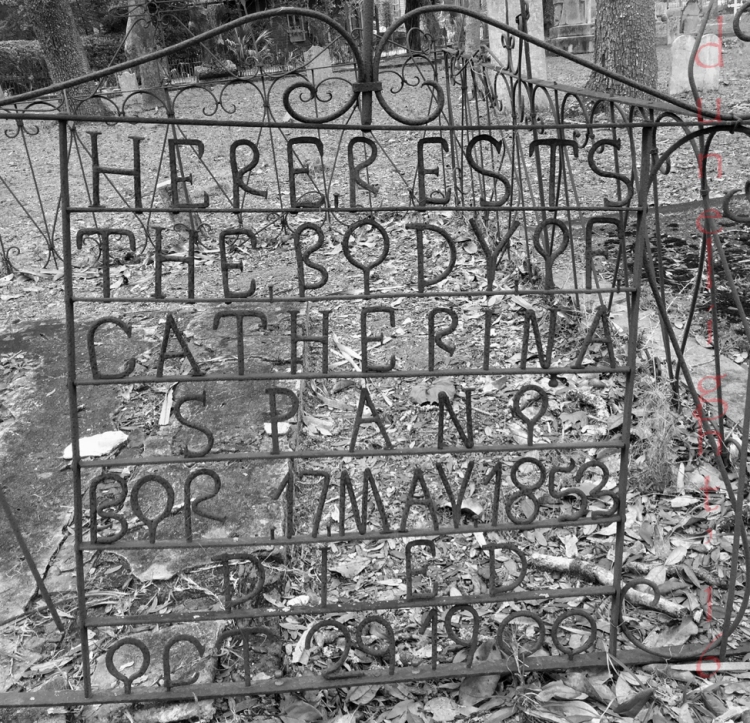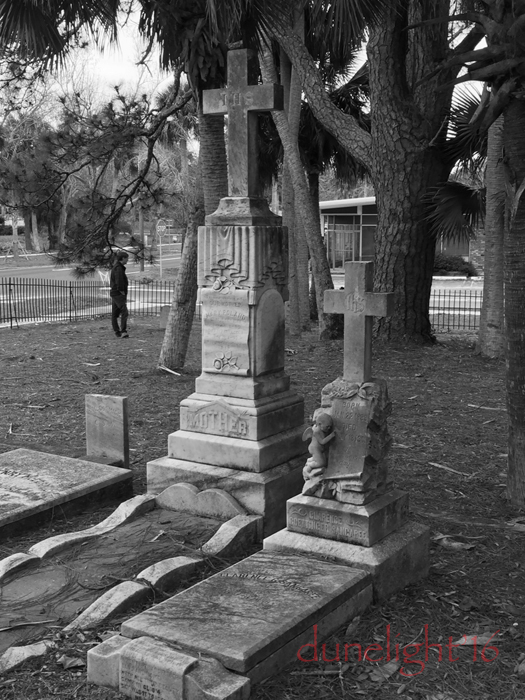I planned to put this up at the end of January as part of the Alphabet Photo Challenge but now that I see it anew I feel it would have been better used as a ‘font’ challenge. I had seen this gate, thought to go back and shoot it for the challenge but ended up with so much more.

The gate is in the Chestnut Street Cemetery in Apalachicola, Florida. It is a fascinating place and it seems a bit chaotic in its layout, which adds to its appeal.

Apalachicola sits at the mouth of the Apalachicola River where it empties into the ecologically rich waters of the Apalachicola Bay. It is well protected from whims of the Gulf of Mexico by barrier islands. In the early 19th century it was one of the largest sea ports in America. Cotton was its life blood and it flowed down the river by steam ships from plantations further north in Georgia and the Carolinas. Its flow was bottled up by the Civil War and the Railroads of the Reconstruction carried the former King Cotton to other ports. For a time Apalachicola was a center for sponge diving but that too passed and now it is a quiet working port for Oyster and Shrimp boats.
A plaque at Apalach’s old city cemetery gate reads:
“Chestnut Street Cemetery dates prior to 1831. Interred are some of Apalachicola’s founders and molders of her colonial history. Also buried here are many soldiers of the confederacy and victims of yellow fever and shipwrecks. Seven of the Confederate veterans served with Pickett at Gettysburg in the gallant Florida Brigade. World famed botanist Dr. Alvin Wentworth Chapman of Apalachicola died in 1899 and is buried here beside the grave of his wife.”
The more I looked the more marvelous old fonts I encountered, each with its own story:
Apalachicola sits in the ‘panhandle’ of Florida referred to as ‘the forgotten coast’. There is a consensus that developers passed her by and most locals like it that way. It is one of the few places you can see “Old Florida”, the Florida before tourists and snowbirds with their high rise condos took over. It, however, is rapidly changing and this idyllic setting of a blue collar working port too shall pass.
Apalach is rated a humid subtropical climate with short mild winters and hot summers. It is perfect for growing those palms, live oaks and all that crazy moss.

Visiting the cemetery and reflecting on those who went before is a perfect way to spend a quiet afternoon.
I went back for the ‘alphabet’ but lingered over the textures and stories.





So thoughtful and poignant.
Thank you, I thought of the shoot often while the images sat on my SD card. When I found the time to put it together there were six newer challenges!
Old cemeteries are often interesting places. The gate is an interesting memorial.
I spent more time looking at that gate than any other memorial. I’d never seen one like that before.
I enjoyed the photos. I guess I’m in a Santa Muerte mood but this was awesome. Epic. xo
I should have saved it for All Saint’s Day but I’m sure I’ll be busy on that day too and late with that theme. 🙂 Thanks..the spanish moss..the heartbreak in some of the stories on the memorials it was moving and quite lovely.
I’m sure it was moving to see everything up close. Best wishes for the day. xo
Thank you! Have a great day too. All is shrouded in fog here.
Thanks very much for your kind thoughts.
great pictures, how on earth has that gate survived so long in such good condition?!
That I do not understand. Florida’s climate..no, I’ll start again, when you get to Florida..the smell..it is the smell of teeming life mixed with a background of decay. The constant battle for supremacy amongst all living things is nowhere more palpable than here. That scent is a mix of green growing things and the rotting smell of whatever it is they just dominated and killed out. So..much life…the marvelous textures on the monuments is caused by lichens and other flora slugging it out. The fact the water table of the entire state is quite high and you’ll find swamps, with their sinking, rotting, teeming vegetation abound adds to the strange olfactory brew.
It is a climate that is indeed hard on things…such as that gate. If you look closely some letters have rotted away. I too am mystified as to how it survived this long. Perhaps family loved her and cared for her memorial until those family members too succumbed to time.
“Our only son”…….this really tugged at my heartstrings. Wonderful photos, Cybele.
Yes..that one..so many ‘lost at sea’..so many yellow fever deaths..so many heart breaks.